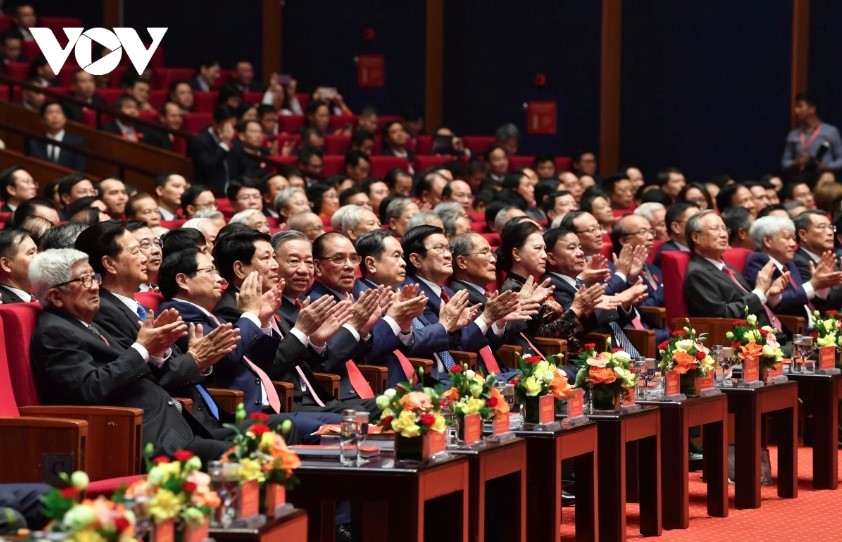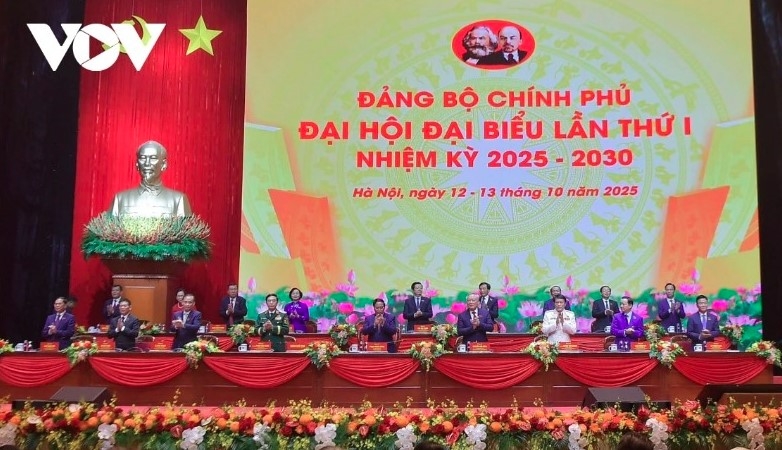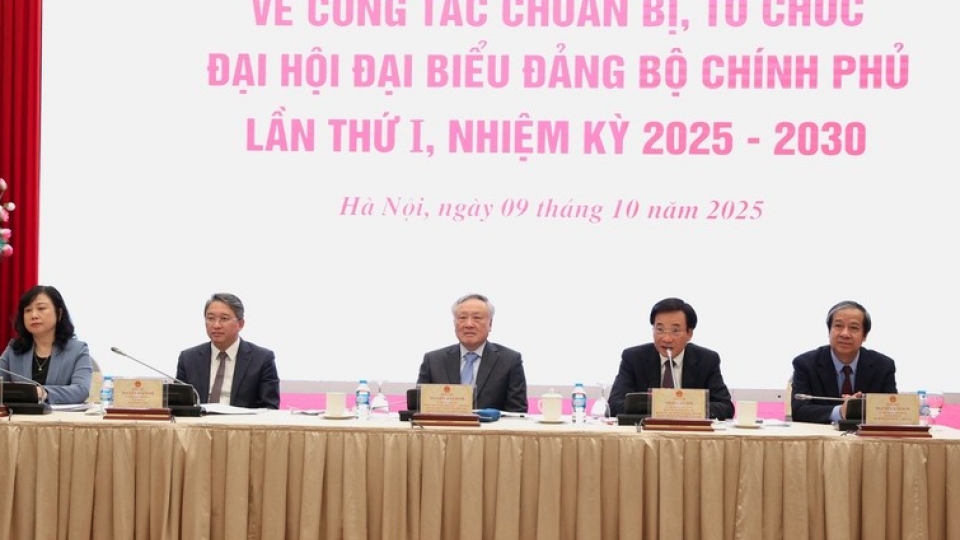Government Party Organisation reviews 2020-2025 term, sets new targets for 2030
VOV.VN - The first Congress of the Government Party Organisation for 2025-2030 has charted a path for rapid economic growth, infrastructure expansion, and comprehensive social development, while setting ambitious targets to position the country among the world’s top 30 economies by 2030.

The first Congress of the Government Party Organization for the 2025-2030 term officially opened in Hanoi, attended by 453 official delegates representing over 209,000 party members from 2,211 grassroots party organizations. General Secretary To Lam was present and delivered a guiding speech.
Those also in attendance included Former General Secretary Nong Duc Manh, President Luong Cuong, former President Truong Tan Sang, Prime Minister Pham Minh Chinh, former Prime Minister Nguyen Tan Dung, National Assembly Chairman Tran Thanh Man, former National Assembly Chairpersons Nguyen Sinh Hung and Nguyen Thi Kim Ngan, Standing Secretary of the Party Central Committee’s Secretariat Tran Cam Tu, former members of the Politburo and the Secretariat, and leaders of ministries, agencies, and central organizations
During the morning session, the Congress heard a report on the outcomes of the preparatory session, the opening remarks by the Secretary of the Government Party Organisation and the Prime Minister, and a verification report on delegates’ credentials.
Over the 2020-2025 term, the Government Party Organization focused on strictly implementing the Party’s resolutions and directives, comprehensively and effectively carrying out all aspects of Party building work, innovating leadership and management methods, maintaining discipline, and strengthening inspection, supervision, and efforts against corruption, waste, and other misconduct.
In his speech, Party leader To Lam stressed that the country must seize opportunities and take bold, proactive steps by combining Vietnamese intelligence with the advanced knowledge of humanity, aiming to soon establish a state of “strategic autonomy.”
Highlighting the important and fairly comprehensive achievements of the Government Party Organization during the 2020-2025 term, the Party General Secretary praised the spirit of openness and frankness in “facing reality squarely, assessing it accurately, and speaking the truth” regarding the shortcomings outlined in the Government Party Organization ’s report.
However, he noted that macroeconomic risks remain, the restructuring of the economy and improvement of growth quality are progressing slowly, and infrastructure, particularly in transportation, urban development, healthcare, education, and digital systems remains uneven. Institutional and legal frameworks still face many obstacles, and decentralisation, delegation of authority, and administrative reform have yet to be carried out with sufficient vigour.
According to the Party leader, these limitations provide profound lessons, prompting the Government Party Organization to enter the new term with greater determination and stronger actions, addressing weaknesses, leveraging all potential and advantages, and ensuring the organization is truly robust to meet the increasingly high requirements of the country’s new stage of development.
“The Congress needs to engage in frank discussions, clearly analyze the causes, especially subjective causes to devise fundamental, strategic solutions to enhance the effectiveness of the Government Party Organization and the Government in the upcoming term, particularly regarding the leadership, organization, and operation of the government apparatus. This is an important and urgent task that must be fulfilled as soon as possible; now that we have a ‘clear structure and open paths,’ we must ‘move steadily and firmly’ into the new era,” the Party chief affirmed.

He also emphasized the need to prioritize economic development, maintain macroeconomic stability, control inflation, and safeguard key economic balances. For the 2026–2030 period, the goal is to achieve double-digit growth. Monetary and fiscal policies must remain flexible and effective, while bottlenecks and obstacles to production and business are addressed. Efforts should revitalize traditional growth drivers and create breakthroughs in emerging sectors, including the digital economy, green economy, and circular economy. A new growth model is envisioned, promoting rapid yet sustainable development, with science, technology, innovation, and digital transformation as its core driving forces.
Attention should be given to implementing three strategic breakthroughs in institutions, infrastructure, and human resources. Institutions must become a competitive advantage; unlocking the full potential of production and mobilizing all development resources; administrative procedures should be streamlined and simplified, fostering creative entrepreneurship and improving the business environment.
Investment is expected to complete strategic infrastructure in transportation, seaports, high-speed rail, and urban rail systems, while programs are being explored and implemented to utilize space, maritime, and underground potentials, opening new avenues for economic development.
Education and training must be consistently prioritized as a “top national policy,” building a modern national education system on a par with regional and global standards, with clear improvements in quality across all levels of education.
Cultural development should advance alongside economic and social progress, ensuring the well-being of all citizens and leaving no one behind, while fostering a civilized, united, and progressive society. Social equity and advancement are priorities, with ongoing improvements in healthcare and social security, and careful attention to ethnic and religious matters. National defence and security will be strengthened, alongside effective promotion of foreign affairs and international integration.
The General Secretary urged the Government to direct relevant agencies to review, reassess, and devise more proactive, systematic, and long-term solutions for disaster prevention, response, and mitigation, rather than relying on temporary measures as currently practiced.
He expressed confidence that with strong political resolve, solidarity, high determination, intellect, and aspiration, the Government Party Organisation will uphold its proud traditions, excel in fulfilling all assigned tasks, and contribute alongside the entire Party, people, and armed forces to successfully carrying out the Resolution of the 14th National Party Congress, thus leading the country into a new era of peace, independence, democracy, prosperity, civilization, happiness, and steady progress toward socialism.

Upon addressing the congress, PM Pham Minh Chinh stated that the first Congress of the Government Party Organisation for the 2025-2030 term was held to review and assess the leadership and management performance of the Government Party Committee during the 2020–2025 term; to define directions, objectives, tasks, and solutions for 2025–2030; and to discuss and contribute opinions on the draft documents of te Party Central Committee to be submitted to the 14th National Party Congress.
He emphasized that the Congress is a particularly important political event for the Government Party Organisation and a historic milestone in the journey of building a transparent, proactive, and action-oriented Government that serves the nation and the people. It aims to meet general political requirements and the tasks of the “organisational restructuring revolution,” ensuring the Party’s comprehensive, absolute, and direct leadership over the Government Party Organisation and the Government, which functions as the highest state administrative body exercising executive authority.
“The Government Party Organization serves as the core political leadership for the operations of the Government, ministries, sectors, and subordinate agencies, particularly in guiding, directing, and managing state administration. It ensures the timely and effective institutionalisation and implementation of the Party’s and State’s guidelines, policies, and directions, contributing to the proper implementation of set objectives and tasks across all sectors,” PM Chinh stressed.
He called on the Congress to conduct in-depth analysis and forecasting of the current context and to give opinions on key directions, tasks, and solutions for the upcoming term. A central question, he noted, is how to build a clean, strong, and united Government Party Organisation that sets an exemplary lead in science and technology, innovation, and digital transformation, while mobilising all of the country’s resources to achieve breakthrough acceleration and national development in the new context.
During the previous tenure, the Government Parrty Organization led subordinate party committees and organizations to closely follow the Party’s policies, implementing all tasks and solutions across sectors efficiently and comprehensively. Particularly in the last two years of the term, it decisively and flexibly led the implementation of strategic, historic decisions of the Party and State, including administrative restructuring, the establishment of a two-level local government model, and the enactment of Politburo resolutions in key areas, thereby laying a solid foundation for the country’s entry into a new development phase.
Despite numerous difficulties, challenges, and unprecedented issues, thanks to the efforts of the entire political system and the people under the Party’s leadership, Vietnam is projected to achieve and surpass 22 out of 26 socio-economic targets for the 2021-2025 period, fully meeting all social targets. In 2024-2025, all 15 key socio-economic indicators are expected to be met or exceeded. Economic growth, though impacted by COVID-19 in 2021 with a rate of 2.55%, averaged 6.3% over the period, close to the target range of 6.5-7%.
Vietnam’s GDP rose from US$346 billion in 2020, ranking 37th globally, to US$510 billion in 2025, climbing five ranks to 32nd worldwide and fourth in ASEAN.
Significant results were achieved through three strategic breakthroughs: innovating legal and regulatory thinking with decentralization, removing development bottlenecks, and mobilizing resources. Investment in infrastructure opened new development spaces, with 3,245 km of expressways and around 1,900 km of coastal roads expected to be completed by the end of 2025, exceeding targets. Long Thanh International Airport is substantially finalized, and several ring roads and metro lines have been implemented or opened.
Cultural and social development, social progress and equity, and social welfare have advanced significantly. People’s living standards continue to improve. Primary healthcare, preventive medicine, and medical service quality have gradually risen. Fundamental, comprehensive reforms in education and training have achieved positive results. The target to eliminate temporary and dilapidated housing ahead of schedule by five years and four months was achieved, with over 334,000 units completed.
National defense and security have been reinforced, with social order and public safety maintained. Sovereignty and territorial integrity are preserved, and budget savings combined with higher revenue have provided the largest-ever allocation for defence and security.
Foreign affairs and international integration remain a highlight, with great achievements in economic diplomacy, enhanced international prestige and position, and a peaceful, stable environment that opens unprecedented development opportunities.
The Congress set the target that by 2030, Vietnam will become a developing country with modern industry, high middle-income status, among the top 30 economies by GDP, and ranked third in ASEAN. The nation also targets strong economic growth from 2026 to 2030.

The country aims for dynamic, fast, and sustainable economic development, ensuring macroeconomic balance. Laws and governance institutions will be modern, competitive, effective, and efficient; infrastructure will be synchronous and modern; human resources will develop comprehensively; and science, technology, and innovation will be among the leading groups in upper-middle-income countries.
The report outlined key socio-economic, environmental, and Party building targets: average annual GDP growth of 10% or higher, with GDP per capita reaching about US$8,500 by 2030.
The report emphasized five groups of tasks and solutions for Party building, underlining strict and effective implementation of the Party’s five leadership principles, particularly democratic centralism, constitutional and legal compliance, and the Party’s five leadership methods, especially exemplary leadership.
Ten key tasks and solutions include: completing development institutions rapidly to unleash production capacity and mobilize all resources; establishing new growth models and restructuring the economy; boosting industrialization and modernization; prioritizing science, technology, innovation, and digital transformation; developing modern national education and high-quality human resources; building synchronous, modern infrastructure; exploiting new development spaces, using cities as hubs to stimulate regional growth, and advancing new rural development; promoting culture, social progress, and equity; enhancing citizens’ material and spiritual well-being and health; managing resources efficiently; protecting the environment and adapting to climate change; and strengthening disaster prevention and mitigation.
Additionally, the report calls for consolidating national defence and security, maintaining social order and safety, creating a peaceful and stable environment, enhancing foreign affairs and international integration, particularly economic diplomacy, enhancing Vietnam’s role, status, and prestige, and building a strong, prosperous, civilized, and happy country. It also emphasizes building a socialist rule-of-law state that is proactive, transparent, action-oriented, and service-focused, and improving social governance capacity.





